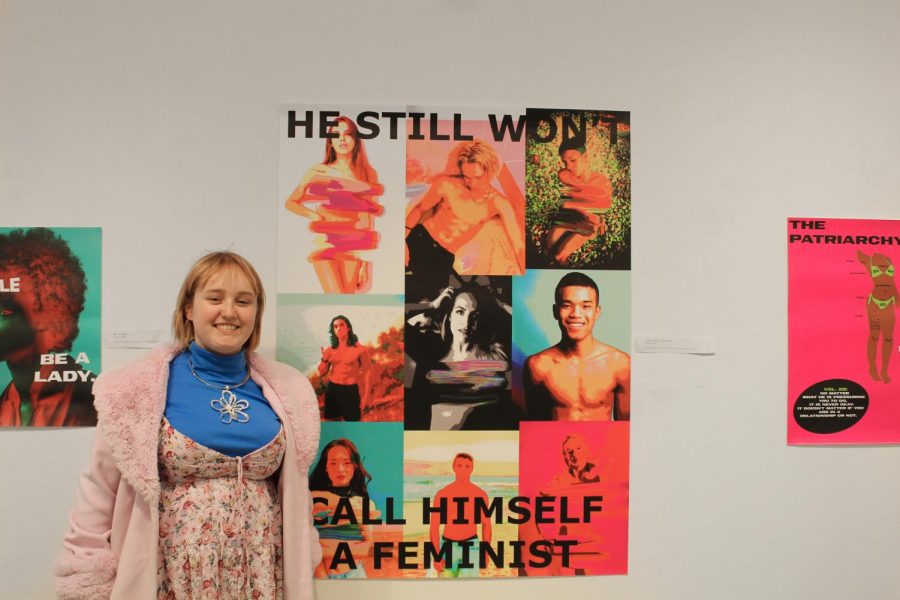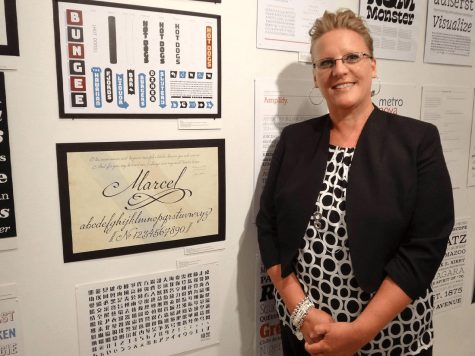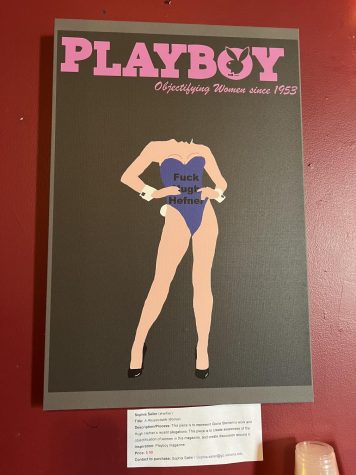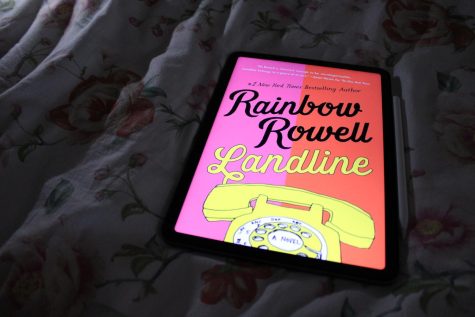Winona State student’s artwork provokes thought on societal expectations
From Oct. 16 to Oct. 22, Weber Art Gallery hosted Sophie Sailer’s “And He Still Won’t Call Himself a Feminist” on the second floor of Watkins Hall. All of Sailer’s pieces cover a variety of topics, but all contribute to an overall discussion about society. Sailer pictured with “The Duality of Boobs”.
October 26, 2022
Conversations regarding societal expectations of women seem to be often present in many peoples’ lives around campus. From Yik Yaks complaining about men only wanting certain things, to classroom discussions about how societal ideals from the 1600s still find their way into today’s world, the discussion of feminism is very relevant in college.
Sophia Sailer, a third-year creative digital media and mass communication majors, sought to deep dive into these conversations regarding feminism in the form of art. From Oct. 16 to Oct. 22, “He Still Won’t Call Himself a Feminist” was shown in the Weber Art Gallery on the second floor of Watkins Hall.
“So what my idea was for the pieces was a conversation between two women, because I have conversations in my daily life,” Sailer said. “I have many female friends and I have many friends that we talk about deep subjects with because we have to because we’re involved in them.”
All of Sailer’s pieces cover a variety of topics, but all contribute to an overall discussion about society. Many of the pieces question societal expectations and differences between sexes and gender, including the main piece, “The Duality of Boobs”.
“The Duality of Boobs” calls into question the societal differences when it comes to shirtless males and shirtless females. Nine panels feature nine different people, four of them male and five of them female; the five females’ breasts are blurred, while the four males’ are not. “And He Still Won’t Call Himself a Feminist” is placed in text over these images, hence the name of the exhibit.
“‘And He Won’t Call Himself a Feminist’ is just showcasing: we both have boobs,” Sailer stated. “Why can only one of us show them?”

One of the most jarring and thought-provoking pieces of the exhibit is titled “Punk is Dead”. The piece features a drawn outline of a protestor who attended the Cannes Film Festival to protest violence against women, specifically highlighting the Ukraine crisis. The theme of the festival, being “America,” led to some people not being shown on camera because of their outfits or presentation not being “America-positive.”
“And so when this protester came about, it kind of reminded me about what activism really is and how it’s not really shown through media even nowadays, you know, because it’s too forward leaning, or progressive for even today in Hollywood’s era,” Sailer stated.
Another interesting and jarring piece in Sailer’s collection is titled “Red”. The piece features a black and white image of a crowd, with the only colored objects being red hats. In both German and English, the question “Are we really that far off?” frames the image.
Sailer explained that “Red” questions the political polarization and presence of facism in America in the past couple of years and how that compares to the political climate of the Holocaust in the 1930s.
“I’m not saying that 100% that’s what we’re going through in society or anything. It’s just how have we seen this in pop culture and how have we seen this in politics?” Sailer emphasized. “I think more radical views are getting spotlighted more and more in history because of certain politicians that we’ve seen.”
Sailer reiterated that she believes everyone has a right to their political views and personal values, but that America is going in a direction that we as a society have never seen before, at least in this generation.
Mika Sosnowski, a University of Wisconsin La Crosse student who went to high school with Sailer, commented on the exhibit’s juxtaposing images and messages.
“I like the way [Sailer] contrasts old paintings and images of women with modern feminist sentiments; it makes for a cool and creative medium,” Sosnowski stated. “I’m always a fan of art that starts a conversation.”
Sailer also commented on the interesting conversations she has overheard taking place at the exhibit, and especially noticed the differences in perspectives between people when looking at and analyzing her art. Sailer stated that although she does not expect a positive reaction from everyone, the positive reactions she has seen from people have varied; some viewers find the pieces moving and have more of a somber reaction, while others find them relatable and entertaining.
“I have seen young women come to it and laugh at certain pieces, and because even though these are hard to swallow pills, for some people, it’s just reality,” Sailer explained. “And it’s just, ‘oh my god, that’s so true.’”

(Heidi Hanson)
Sailer’s exhibit, “And He Still Won’t Call Himself a Feminist”, did a wonderful job of executing the narratives of many people in today’s world. From controversial issues such as political climates, to issues regarding contraception accessibility and simple narratives around women, the pieces all worked together to call into question how today’s society is greatly flawed. Each piece is its own story with its own purpose.
A student wrote in the commentary booklet inside the exhibit and praised Sailer for her use of art for activism.
“This is spectacular; the pieces spark rage and healthy distaste towards our fucked up world,” the student said.







































































